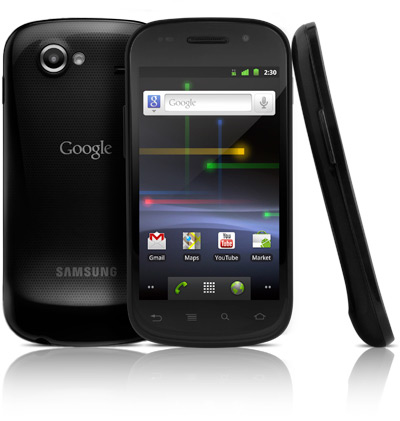Google’s Nexus S to come with NFC, Android 2.3
Dec 6, 2010 — by LinuxDevices Staff — from the LinuxDevices Archive — viewsAlong with today's reveal of Android 2.3 (“Gingerbread”), Google announced a developer-focused phone that will run the operating system upgrade without any carrier-specific add-ons. Based on Samsung's Galaxy S platform, the “Nexus S” features a four-inch AMOLED (active matrix organic light emitting diode) display, quad-band GSM, NFC (near field communication), Wi-Fi, Bluetooth 2.1, and other typical smartphone “must-haves,” the company says.
In conjunction with today's announcement of Android 2.3, Google popped out a developer-focused phone to go with it, the Samsung-manufactured Nexus S (below). Like the operating system upgrade itself, the S was widely rumored in advance of its release, and has only one feature that goes beyond typical smartphone ingredients: its built-in support for NFC (near field communication).

Google's Nexus S
 Google's previous developer phone, the Nexus One (left), was custom-designed for the search giant by HTC. Offered in an unlocked version directly, and — for a while, in a cheaper, contract-linked variant by T-Mobile — the device sold only modestly well, and Google started phasing it out in July.
Google's previous developer phone, the Nexus One (left), was custom-designed for the search giant by HTC. Offered in an unlocked version directly, and — for a while, in a cheaper, contract-linked variant by T-Mobile — the device sold only modestly well, and Google started phasing it out in July.
 Said to have been "co-developed by Google and Samsung," the new Nexus S is based on Samsung's Galaxy S (right), which went on sale in Korea last June and has already spawned a passel of variants. (These include the AT&T-offered Captivate, the T-Mobile Vibrant, and the Verizon Fascinate.)
Said to have been "co-developed by Google and Samsung," the new Nexus S is based on Samsung's Galaxy S (right), which went on sale in Korea last June and has already spawned a passel of variants. (These include the AT&T-offered Captivate, the T-Mobile Vibrant, and the Verizon Fascinate.)
Compared to these earlier versions, the Nexus S offers essentially the same hardware, including a 1GHz Samsung S5PC110 "Hummingbird" system-on-chip, a four-inch AMOLED display with WVGA (800 x 480 pixel) resolution, a five-megapixel main camera, and a VGA-resolution webcam (now supported by Android, as our separate story reports). Other common features include 802.11b/g/n wireless networking and a GPS receiver.
There are two small differences, however, the first being the NFC capability mentioned earlier in this story. According to Google, this will allow Nexus S users to develop or test applications designed to read data from NFC tags that might be embedded in a poster, sticker, or advertisement.
The second difference is that, for whatever reason, the Nexus S reverts to Bluetooth 2.1, instead of the Bluetooth 3.0 that's present on other Galaxy S variants. We're presuming the enhanced personal area networking spec, which is said to allow file transfers at up to 24Mbps, was dropped because of board real estate issues related to NFC.
Meanwhile, says Google, the Nexus S includes quad-band (850, 900, 1800, and 1900MHz) GSM as well as tri-band (900, 1700, and 2100MHz) HSPA (high speed packet access). It also supports 7.2Mbps HSDPA (high speed downlink packet acess) and 5.76Mbps HSUPA (high speed uplink packet access), the company adds.
The Nexus S will operate initially on the T-Mobile network in the United States and on Vodafone in the U.K., according to Google. However, third-party reports (such as this one by InformationWeek's Eric Zenman) criticize the device for appearing to offer neither support for AT&T's GSM frequencies nor T-Mobile's own HSPA+.
For its part, Google suggests that the Nexus S is less about what features it does include, as more about what it doesn't include. Namely, there's no OEM- or carrier-created software that could dilute the Android experience or complicate software testing.
"With this device, users will be … the first to receive software upgrades and new Google mobile apps as soon as they become available," the company says. The implication is that purchasers will not only be the first to rock Android 2.3, but might also be the first to roll with next-year's Android 3.0 ("Honeycomb").
Features and specifications released by Google for the Nexus S include:
- Processor — 1GHz Hummingbird (Samsung S5PC110)
- Memory — 512MB of RAM, 16GB of flash storage
- Display — 4-inch AMOLED display with 800 x 480 pixel resolution
- Expansion — n/s, but reportedly does not include expansion slot
- Cameras — five megapixel (rear-facing); VGA-resolution (front-facing)
- Networking:
- WWAN — quad-band (850, 900, 1800, and 1900MHz) GSM; tri-band (900, 1700, and 2100MHz) HSPA (high speed packet access); 7.2Mbps HSDPA; 5.76Mbps HSUPA (high speed uplink packet access)
- WLAN — 802.11b/g/n
- PAN — Bluetooth 2.1
- Additional wireless capabilities:
- NFC
- GPS
- Other I/O:
- 3.5mm headphone jack
- USB 2.0 port
- Battery:
- 1500mAh
- 6 hours talk time
- 428 hours standby
- Dimensions — 4.87 x 2.48 x 0.42 inches (123.9 x 63 x 10.88mm)
The Nexus S
Source: Google
(click to play)
According to Google, the "unlocked and carrier-independent" Nexus S will go on sale Dec. 16 at Best Buy stores in the U.S., and Dec. 20 at Carphone Warehouse stores in the U.K. Best Buy says the phone will cost approximately $530 without a T-Mobile contract, or $200 with two-year contract.
Google's product page for the Nexus S may be found here, while Best Buy's page may be found here.
A complimentary review by TechCrunch writers who are said to have been using the phone for several days may be found here.
This article was originally published on LinuxDevices.com and has been donated to the open source community by QuinStreet Inc. Please visit LinuxToday.com for up-to-date news and articles about Linux and open source.